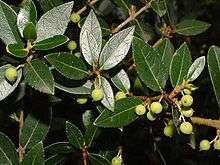Phillyrea
Phillyrea is a genus of two species of flowering plants in the family Oleaceae, native to the Mediterranean region, and naturalized in the Canary Islands and Madeira.[2]
| Phillyrea | |
|---|---|
 | |
| Phillyrea latifolia | |
| Scientific classification | |
| Kingdom: | Plantae |
| Clade: | Tracheophytes |
| Clade: | Angiosperms |
| Clade: | Eudicots |
| Clade: | Asterids |
| Order: | Lamiales |
| Family: | Oleaceae |
| Tribe: | Oleeae |
| Subtribe: | Oleinae |
| Genus: | Phillyrea L. |
| Type species | |
| Phillyrea latifolia[1] | |
They are evergreen shrubs or small trees growing to 3–9 m tall, related to Ligustrum, Olea and Osmanthus. The leaves are in opposite pairs, small, leathery, ovate to lanceolate, 2–6 cm long and 0.5–2 cm broad. The flowers are small, greenish-white, produced in short clusters. The fruit is a drupe containing a single seed.
Species
- Phillyrea angustifolia L. - native to western and central Mediterranean Basin, Portugal to Albania.
- Phillyrea latifolia L. - native to entire Mediterranean Basin, Portugal to Syria.
A third species P. decora from the Caucasus is now usually treated in the genus Osmanthus as Osmanthus decorus. Over 200 other names have been proposed over the years, now considered synonyms of existing taxa.[2]
gollark: Not the core of it.
gollark: It just contains the process manager.
gollark: The "startup file" isn't much of potatOS.
gollark: I know what you mean. I just don't care.
gollark: It's GPT-J, not GPT3-J.
References
- Lectotype designated by: Hitchcock, A. S. 1923. American Journal of Botany 10: 514.
- Kew World Checklist of Selected Plant Families, Phillyrea
This article is issued from Wikipedia. The text is licensed under Creative Commons - Attribution - Sharealike. Additional terms may apply for the media files.